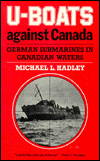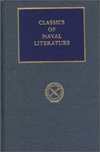U-boats Against Canada
Hadley, Michael
1990, University of Toronto Press
ISBN 0773508015
357 pages, 39 b&w photos, and 1 map
| Type. | General History |
| Pros. | Detailed coverage of U-boat operations in Canadian waters |
| Cons. | None to speak of |
| Rating. |  |
 This book, by the author of Count Not the Dead, was the first to focus entirely on U-boat operations in Canadian waters. The introduction sets the stage with an overview of World War I U-boat activities off Canadian shores, and the reactions to them of the Canadian public as documented in contemporary newspaper accounts. Two themes which recur throughout the book are also outlined in the introduction: the U-boat war in Canadian waters as a psychological war by Dönitz against the Canadian people, as evidenced in propaganda and press reports from both sides; and the tension between the need to defend Canadian shores and the need to aid the Allies, which led to bitter debates about conscription and use of available ships, men, and materiel.
This book, by the author of Count Not the Dead, was the first to focus entirely on U-boat operations in Canadian waters. The introduction sets the stage with an overview of World War I U-boat activities off Canadian shores, and the reactions to them of the Canadian public as documented in contemporary newspaper accounts. Two themes which recur throughout the book are also outlined in the introduction: the U-boat war in Canadian waters as a psychological war by Dönitz against the Canadian people, as evidenced in propaganda and press reports from both sides; and the tension between the need to defend Canadian shores and the need to aid the Allies, which led to bitter debates about conscription and use of available ships, men, and materiel.
Chapter 1 expands upon the lack of men, vessels for defense, materiel, and training which confronted Canada in 1939, and describes the plans made at various stages of the war for coastal defense, noting that prewar plans did not focus on U-boats as the major threat. This chapter also covers the first operations of U-boats in Canadian waters in 1941, the consequences of the closure of the Gulf of St. Lawrence on railroads and the economy, and the decision not to darken navigation lights or silence transmission buoys (it was thought that the danger of friendly vessels grounding was worse than the danger of easing the passage of the enemy). Subsequent chapters cover Operation Drumbeat; preliminary actions in the St. Lawrence; and a comprehensive account of the Battle of the St. Lawrence, including the sinking of HMCS Charlottetown by Hartwig (U-517) and of the ferry SS Caribou by Gräf (U-69).
Chapter 5 deals with the fascinating subject of spies and intelligence devices delivered to Canadian shores by U-boats, including Langbein (dropped off by U-213), Janowski (deposited by U-518), and Weather Station Kurt. The preparation for the spy missions was poor (both spies were supplied with currency dating from 1917, notes which were conspicuously larger in size than 1940s currency; the sole Canadian contact provided for Janowski was actually in prison, and had been there for two years, following a well-publicized arrest which German organizers had somehow failed to note); and the results were similarly unimpressive (Langbein simply lived on the money he'd been supplied and did no spying at all, while Janowski was arrested within 24 hours and became a double agent). As Hadley notes, only Weather Station Kurt was successful, and in fact escaped detection for 40 years.
Chapter 6 covers U-boats used in minelaying and in attempts to pick up escaped German POWs - Operations Elster and Kiebitz. Further chapters explore events in the latter years of the war, including a detailed account of the sinking of frigate HMCS Valleyfield by U-548 (Zimmermann); the impact of the Schnorchel on operations; the operations of U-806 (Hornbostel) and other boats in December, 1944; a successful mission late in the war by U-1232 (Dobratz); and events in the closing days of the war.
An appendix presents some interesting song lyrics, including the words (German and English translation) to a song about the Schnorchel sung on U-541 to the tune of Lili Marlene.
Review written by Tonya Allen.
Published on 5 Nov 2000.
This title is highly recommended.
Return to our main review page.



